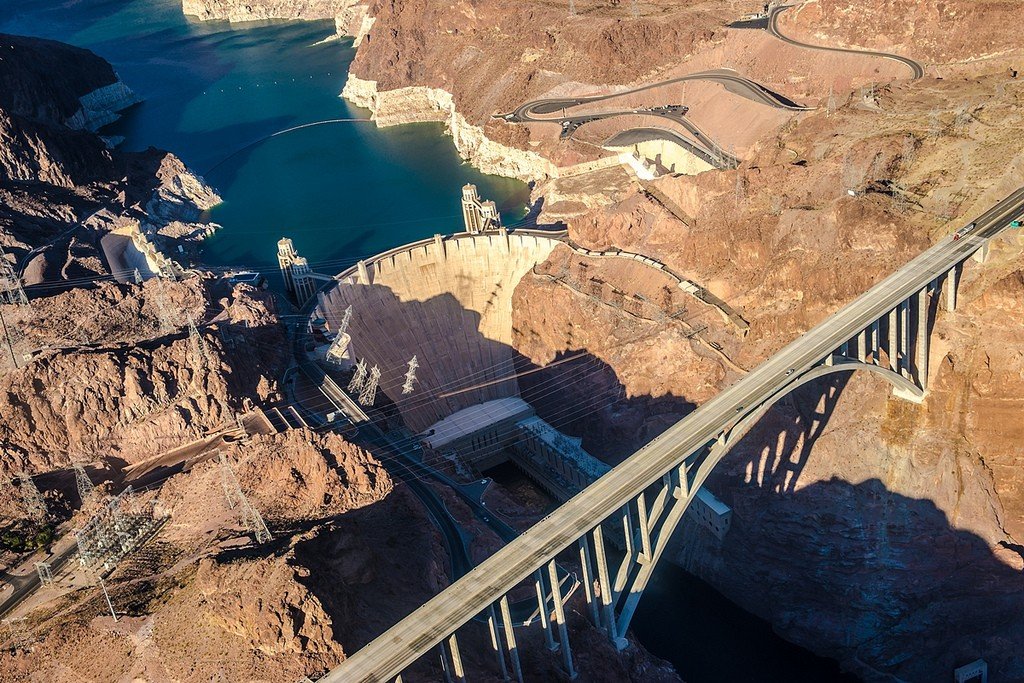Hoover Dam
Since its completion, the Hoover Dam on the Colorado River, on the border between Arizona and Nevada, has become the largest dam in the world. It was immediately recognized as a modern-day wonder of the world.
Hoover Dam is one of the tallest dams in the world and the largest hydroelectric power plant in the United States. Although not really a dam, the Hoover Dam is more of an additional wall up to 220 meters high that holds back the waters of the Colorado River in the Black Canyon, 50 km southeast of Las Vegas, Nevada. It locks Lake Mead, the largest man-made reservoir in the United States.










Video: Hoover Dam
General Information
Technically, Hoover Dam is a reinforced concrete wall curved toward Lake Mead. Because of this curved shape, the wall can easily withstand the pressure of 35 billion cubic meters of water. The construction of this wall was once a true challenge to modern technology. The unbearable heat of the desert, when in summer the thermometer column rises to 50 ° C, was the main problem from the very beginning. Because of the high temperature, it was impossible to simply pour all the concrete into the formwork. In this case, the high ambient temperature would have prevented the liquid mass of concrete from hardening for only 125 years! It was decided to use a different technique. Engineers assembled the Hoover Dam from individual concrete blocks, which were fastened together right on site.
.
A system of pipes was left in the concrete blocks in advance. Ice water was poured into them. The water cooled the mass of concrete and it hardened as it should. After that the concrete was poured into the pipes themselves. This also made the structure stronger. The pipes not only played the role of reinforcement (metal beams that make up the frame of modern reinforced concrete structures), but also securely fastened the individual blocks together. All blocks had equal height – 1.5 meters. The other dimensions depended on the point at which each individual block was to be placed in the dam. The largest blocks had a cross-section of 7.6 X 18 m, the smallest – 7.6 X 7.6 meters. The total amount of concrete needed for the dam was 2.6 million cubic meters – it is hard to imagine such a quantity of concrete! It would have been enough to pave a 20 cm thick and 5 m wide roadway across the States, from San Francisco to New York!
.The Colorado River had to change its course for the duration of the construction. To this end, huge tunnels were dug into the canyon walls, through which the builders diverted the water. In total there were 4 tunnels, the largest one with a 17 m diameter gap and a length of 5 km. 3500 people worked on the construction site, 96 of whom died.
.
The dam was originally expected to cost $49 billion. But in the end this figure more than tripled: 165 billion! The exorbitant costs were recouped through the sale of electricity and tourism only by 1985.Since then, the Hoover Dam has been taken off the debtor’s list and has been making a net profit.
.
Facts
- Time of construction: the Hoover Dam was built between 1931 and 1,935. It cost $1,65 billion dollars to build.
- Electricity production: The power plant started up on September 1 2, 1 936.Now 1 7 modern turbines produce 2,000 MW of electricity per year. This equates to over 4 billion kWh of electricity, enough to
- meet the needs of 1.3 million Americans living in the southwestern states.
- Construction materials: the Hoover Dam is constructed of 2.6 million cubic meters of concrete and weighs 6.6 million tons. .
- Reservoir size: Lake Mead is 177 km long, has an area of 640 square kilometers and a shoreline of 885 km. It has a maximum depth of 180 meters and a capacity of up to 35 billion cubic meters of water.”
